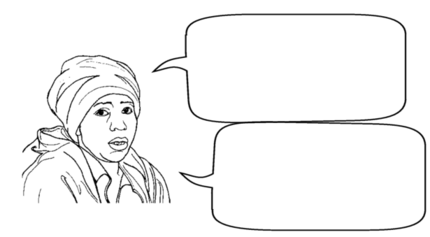Hesperian Health Guides
Pesticides Harm the Environment
HealthWiki > A Community Guide to Environmental Health > Chapter 14: Pesticides Are Poison > Pesticides Harm the Environment
Pesticides not only poison people and pests. They also harm other parts of the environment.
Pesticides poison animals when they eat, drink, and breathe them, just as pesticides poison people. The pesticides collect in their bodies and when larger animals eat smaller ones, the stored amount of poison gets larger too.

cotton farm I sprayed some termites with endosulfan. Later a frog ate the dying termites.
Pesticides poison the soil when they kill the insects, worms, fungi, and bacteria which create nutrients that keep soil alive and fertile.
Pesticides poison water when they run off into streams. They kill fish and harm animals and people that drink the water.
Pesticides poison air when they drift in the wind. Pesticides can travel many miles from where they were used.
How pests become
|
 |
| The pesticide kills most pests, but some survive because they are resistant. |
 |
| The pests that survive give birth to more resistant pests. |
 |
| Soon, all the pests are resistant, and pesticides no longer work. |
Resistance to pesticides
There are always a few pests that do not die when they are sprayed because they are stronger or have chemicals in their bodies that block the pesticide. They give birth to other pests that have the same strengths and are not harmed by pesticides. This is called pesticide resistance. More and more pests are born with resistance, and that leads to a whole population of resistant pests that can no longer be killed with the same chemicals.
Pesticide companies then create new or stronger pesticides to kill resistant pests. Farmers buy the new chemicals, spending more money each season. Each year the environment is poisoned with more chemicals, more pests become resistant, and the pesticide companies make more profit.
While pesticides may reduce crop losses from pests for a few seasons, in the long run they poison people, animals, the ground, and the water. The only long-term benefit goes to the chemical companies that make and sell them.
Pesticides kill helpful insects
Not all insects are pests. Many insects are helpful to farmers. Bees pollinate plants and make honey. Ladybugs attack insects that damage crops. There are more helpful insects than there are “pests.” But pesticides usually kill both the “good” insects and the “bad” insects.
For example, when a field is sprayed to kill aphids, the poison also kills the spiders and ladybugs that eat aphids. Without spiders and ladybugs to control them, more aphids come back.


